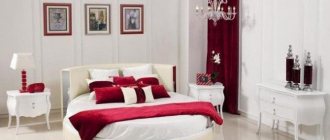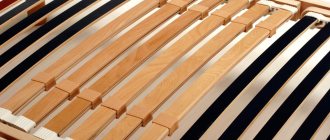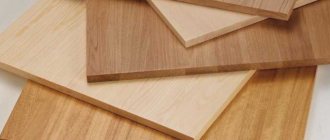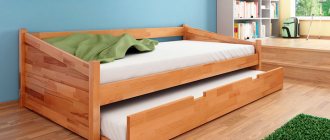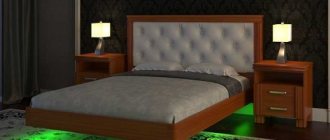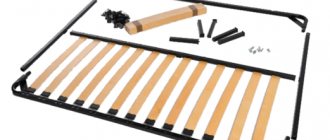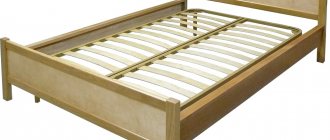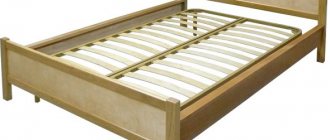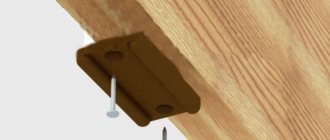0
35363
Traditional beds with mesh bases are practically not used today. They do not provide proper support to the spine, which leads to the development of musculoskeletal diseases. Modern sleeping places are equipped with an orthopedic base, the springing ability of which is the key to a comfortable sleep. The metal frame of the base is filled with slats for the bed, which can be of different widths and lengths. The plates have a curved shape, are elastic and durable.
What are bed slats
The slats in the bed are structural elements of the slatted base on which the mattress is placed. They are wooden slats (see photo below) installed across the base at a certain distance from each other. In order to create an elastic base during installation, they must have a C-shape, slightly curved upward.
Photo: Bed with slats (slat base)
What are they needed for
In the overall design, the slats have many useful functions:
- create natural ventilation for the mattress due to the presence of gaps between them;
- needed to reduce the load on the bed frame. Evenly distribute the weight of the mattress under itself, thereby extending the life of the bed;
- thanks to the curved shape, they create a light springing effect and increase the anatomical effect of the mattress, complementing its orthopedic properties;
There are also special orthopedic lamellas that allow you to adjust the rigidity of the base at its various points, selecting the optimal rigidity characteristics for the physiological characteristics of the sleeper. However, their high price does not yet allow this invention to become a mass product.
Photo: Orthopedic base for a slatted bed
Required lamella size to order
Didn't find the lamella size you need in our catalog? We will make slats for the base of the bed in the required size, in any quantity.
Small bed slats 38x8 , maximum possible length 990 (mm) , suitable for furniture from manufacturers: DREAMLAND, IKEA, HOFF, and others.
Available sizes (mm):
| 38x8x710 | 38x8x715 |
| 38x8x750 | 38x8x755 |
| 38x8x790 | 38x8x795 |
| 38x8x800 | 38x8x800 |
| 38x8x830 | 38x8x835 |
| 38x8x850 | 38x8x855 |
| 38x8x860 | 38x8x865 |
| 38x8x890 | 38x8x895 |
| 38x8x900 | 38x8x990 |
| Order your size | |
Material: birch veneer
Manufacturer: Russia
Bend radius: 4500 mm
Price 1 piece — 85 rub.
Buy in one click
Small bed slats, 50 mm wide and 8 mm thick, maximum possible length 990 mm
Available sizes (mm):
| 50x8x530 | 50x8x535 |
| 50x8x540 | 50x8x545 |
| 50x8x590 | 50x8x595 |
| 50x8x610 | 50x8x615 |
| 50x8x630 | 50x8x635 |
| 50x8x680 | 50x8x685 |
| 50x8x690 | 50x8x695 |
| 50x8x720 | 50x8x725 |
| 50x8x730 | 50x8x735 |
| 50x8x750 | 50x8x755 |
| 50x8x770 | 50x8x775 |
| 50x8x780 | 50x8x785 |
| 50x8x790 | 50x8x795 |
| 50x8x800 | 50x8x805 |
| 50x8x850 | 50x8x855 |
| 50x8x860 | 50x8x865 |
| 50x8x880 | 50x8x885 |
| 50x8x890 | |
| Order your size | |
Material: birch veneer
Manufacturer: Russia
Bend radius: 4500 mm
Price 1 piece — 90 rub.
Buy in one click
Small bed slats, 53 wide and 8 mm thick, maximum possible length 990 mm
Available sizes (mm) of slats for beds and sofas from IKEA, Leroy Merlin, SHATURAMEBEL, HOFF, STOLPLIT, ASKONA, ORMATEK, TORIS, Dimax and others.
| 53x8x530 | 53x8x535 |
| 53x8x540 | 53x8x545 |
| 53x8x590 | 53x8x595 |
| 53x8x600 | 53x8x605 |
| 53x8x610 | 53x8x615 |
| 53x8x630 | 53x8x635 |
| 53x8x660 | 53x8x665 |
| 53x8x670 | 53x8x675 |
| 53x8x680 | 53x8x685 |
| 53x8x690 | 53x8x695 |
| 53x8x700 | 53x8x705 |
| 53x8x710 | 53x8x715 |
| 53x8x720 | 53x8x725 |
| 53x8x730 | 53x8x735 |
| 53x8x750 | 53x8x755 |
| 53x8x760 | 53x8x765 |
| 53x8x770 | 53x8x775 |
| 53x8x780 | 53x8x785 |
| 53x8x790 | 53x8x795 |
| 53x8x800 | 53x8x805 |
| 53x8x830 | 53x8x835 |
| 53x8x850 | 53x8x855 |
| 53x8x860 | 53x8x865 |
| 53x8x880 | 53x8x885 |
| 53x8x890 | 53x8x895 |
| 53x8x910 | 53x8x915 |
| 53x8x990 | |
| Order your size | |
Material: birch veneer
Manufacturer: Russia
Bend radius: 4500 mm
Price 1 piece — 90 rub.
Buy in one click
The slats are medium, 63 mm wide and 8 mm thick, maximum possible length 910 mm
We have slats for beds and sofas from, "Ryton", "Borovichi", "Perrino", "City", "Relax", "Factory 8 March" and other manufacturers of upholstered furniture.
| 63x8x530 | 63x8x535 |
| 63x8x590 | 63x8x595 |
| 63x8x620 | 63x8x625 |
| 63x8x630 | 63x8x635 |
| 63x8x640 | 63x8x645 |
| 63x8x650 | 63x8x655 |
| 63x8x660 | 63x8x665 |
| 63x8x680 | 63x8x685 |
| 63x8x690 | 63x8x695 |
| 63x8x700 | 63x8x705 |
| 63x8x720 | 63x8x725 |
| 63x8x740 | 63x8x745 |
| 63x8x750 | 63x8x755 |
| 63x8x760 | 63x8x765 |
| 63x8x780 | 63x8x785 |
| 63x8x790 | 63x8x795 |
| 63x8x800 | 63x8x805 |
| 63x8x850 | 63x8x855 |
| 63x8x860 | 63x8x865 |
| 63x8x870 | 63x8x875 |
| 63x8x880 | 63x8x885 |
| 63x8x890 | 63x8x895 |
| 63x8x900 | 63x8x905 |
| 63x8x910 | |
| Order your size | |
Material: birch veneer
Manufacturer: Russia
Bend radius: 4500 mm
Price 1 piece — 100 rub.
Buy in one click
The slats are medium, 67 mm wide and 8 mm thick, maximum possible length 910 mm
This size of slats is usually used in imported upholstered furniture
| 68x8x530 | 68x8x535 |
| 68x8x590 | 68x8x595 |
| 68x8x620 | 68x8x625 |
| 68x8x630 | 68x8x635 |
| 68x8x640 | 68x8x645 |
| 68x8x650 | 68x8x655 |
| 68x8x660 | 68x8x665 |
| 68x8x680 | 68x8x685 |
| 68x8x690 | 68x8x695 |
| 68x8x700 | 68x8x705 |
| 68x8x720 | 68x8x725 |
| 68x8x740 | 68x8x745 |
| 68x8x750 | 68x8x755 |
| 68x8x760 | 68x8x765 |
| 68x8x780 | 68x8x785 |
| 68x8x790 | 68x8x795 |
| 68x8x800 | 68x8x805 |
| 68x8x850 | 68x8x855 |
| 68x8x860 | 68x8x865 |
| 68x8x870 | 68x8x875 |
| 68x8x880 | 68x8x885 |
| 68x8x890 | 68x8x895 |
| 68x8x900 | 68x8x905 |
| 68x8x910 | |
| Order your size | |
Material: birch veneer
Manufacturer: Russia
Bend radius: 4500 mm
Price 1 piece — 130 rub.
Buy in one click
The lamellas are large, 63 wide and 12 mm thick, the maximum possible length is 1320 mm.
(Commonly used in French clamshell mechanisms)
Available sizes:
| 63x12x610 | 63x12x615 |
| 63x12x630 | 63x12x635 |
| 63x12x720 | 63x12x725 |
| 63x12x790 | 63x12x795 |
| 63x12x800 | 63x12x805 |
| 63x12x820 | 63x12x825 |
| 63x12x890 | 63x12x895 |
| 63x12x900 | 63x12x905 |
| 63x12x910 | 63x12x915 |
| 63x12x1320 | |
| Order your size | |
Material: birch veneer
Manufacturer: Russia
Bend radius: 8000 mm
Price for 1 piece. — 180 rub.
Buy in one click
The slats are wide, 83 wide and 8 mm thick, the maximum possible length is 1320 mm.
Available sizes:
| 83x8x510 | 83x8x515 |
| 83x8x540 | 83x8x545 |
| 83x8x630 | 83x8x635 |
| 83x8x670 | 83x8x675 |
| 83x8x690 | 83x8x695 |
| 83x8x720 | 83x8x725 |
| 83x8x820 | 83x8x825 |
| 83x8x850 | 83x8x855 |
| 83x8x890 | 83x8x895 |
| 83x8x910 | 83x8x915 |
| 83x8x1320 | |
| Order your size | |
Material: birch veneer
Manufacturer: Russia
Bend radius: 8000 mm
Price for 1 piece. — 160 rub.
Buy in one click
Didn't find the size of slats you need in our catalog? We will produce slats for the bed frame in the required size, in any quantity.
What are lamellas made of?
These structural elements can be made of wood as well as metal.
Wooden
Wooden bed slats are made from birch, linden, ash, maple, and beech. The most common and inexpensive are birch. They are light in weight and handle loads well. The most durable are beech.
Metal
They are much less common than the previous version. They differ in that they do not change their hardness throughout the entire service life. They do not bend under the mattress, but they have significant weight and can also make squeaks.
If the metal slats have an anti-corrosion coating, then the bed can be used in any humidity and temperature conditions.
It is also important that fewer crossbars made of metal are required than wooden ones. Cast welded bases do not require a special central guide. Metal slats are often used in beds with a lifting mechanism due to their significant weight.
Sizes of bed slats
There are two types of lamellas in width: narrow and wide.
- Narrow ones (30-40 mm) must be placed in two rows, with each sleeping place having a separate base. This type of lamella arrangement is suitable for mattresses with independent springs.
- Wide slats (50-70 mm) are arranged in one row, unlike narrow ones, and are most often used in single or single beds. Wide slats are suitable for use with springless mattresses, as well as with Bonnell spring models.
The most acceptable thickness of the slats is 8-10 mm. The length of the slats may vary depending on the width of the bed.
Why do we need slats?
The base of an orthopedic bed is currently assembled like a puzzle. It consists of two to three dozen slats - lamellas, which are united by one frame. The slats serve as the bottom of the bed; a mattress with orthopedic characteristics is placed on them. Modern mattresses do not have uneven surfaces and are quite heavy in weight. The slats perform the following tasks:
- Ventilate the mattress, allowing air to circulate.
- They reduce the pressure exerted on the mattress, as well as the load transferred to the base of the bed.
- Increases the anatomical capabilities of the mattress.
- They allow you to create a spring effect, which is achieved by their shape. Thanks to it, there is no squeaking.
- Extend the life of the bed.
Number of slats per bed
The number of slats depends on the material from which they are made. You will need less metal ones than wooden ones.
If we talk about wooden ones, then usually 25-30 pieces of bent-glued plates are used for a double bed. There are at least 15 slats per single bed. For comparison: you will need only 8-10 metal slats for a single bed.
The more slats are used, the better they will be able to withstand the load and provide flexibility to the base and cushioning of the mattress. But the fewer there are, the more it is ventilated.
Types of lamellas
Lamellas are divided into two main types: narrow and wide.
Narrow
The length of one yard is from 7 to 8 centimeters
They are usually located in two rows. In other words, there is one row for every sleeping position.
This type is best installed if the mattress is filled with independent springs.
Narrow slats are suitable for placement on the frame of a spring mattress
Wide
Wide slats are longer than narrow ones: this parameter is 9-10 cm
This type is arranged in a single row on the grille. They are most often used in single and semi-double beds.
Basically, springless mattresses or mattresses equipped with Bonnell springs are suitable for such a base.
Wide slats are suitable for springless mattress options
For a bed with two beds, the number of slats is considered to be 25 - 30 pieces. For one sleeping place there must be at least 15 slats.
The largest number of slats makes the bed more flexible and it can support quite a lot of weight.
You also need to take into account that the slats differ from each other:
- thick;
- length;
- width;
- distance between slats.
It is believed that the best lamella thickness is from 0.08 to 0.1 centimeters, a width from 5 to 7 centimeters, and the length will be the width of the bed or half of it.
The optimal distance between the yards can vary from 4 to 7 centimeters
There are also additional characteristics that help distribute lamellas by type.
For example:
- Type of base. It can be either wooden or metal.
- There are legs or they are missing.
- How are they attached?
- By size, that is, narrow or wide yards.
- Transformers, that is, is it possible to take any comfortable position while resting.
- Which options are used, straight or with a spring effect?
- Is it possible to adjust the hardness?
- By size.
- According to the color palette.
A bed with or without slats: which is better?
The choice of slats material depends on the preferences, as well as the financial situation of the buyer.
It will be more difficult and expensive to manufacture a slatted bottom; a solid bottom is cheaper, but it provides worse orthopedic properties of mattresses. Most mattresses reveal their properties precisely in tandem with slats.
For comparison, let's look at the advantages and disadvantages of each of the bases.
Solid bed bottom
Pros:
- Ease of manufacture and versatility.
- Suitable for people with spinal problems who need a flat and hard surface.
Minuses:
- poor ventilation;
- does not have springing properties;
- provides worse orthopedic properties of the mattress.
Lamellar base
Advantages of lamellas:
- Excellent ventilation.
- The orthopedic properties of the mattress increase.
- The slatted bottom type is more suitable for those who do not have too much weight.
- If the slats break, they can always be replaced, but if the bottom of the bed breaks, it can only be taken to a landfill.
- One lamella can withstand a load of 12 kg and in case of breakdown you will not have to change all the lamella fastenings.
- The bed is easier to move and transport.
- Plastic lat holders do not creak.
- Flexibility and resilience.
- Affordable price.
- Quick replacement.
- Easy to disassemble and assemble.
- Suitable for beds with a lifting mechanism.
- Has springy properties.
Minuses:
- may break;
- the cheapest models may squeak;
- Sometimes the slats pop out of the plastic tips.
To summarize, we can conclude that the base with slats wins on many counts. In the vast majority of cases, this is what is best for the bed.
The slats on the bed are creaking: what to do?
To assess the scale of the problem, you need to take a closer look not only at the slatted base, but also at the mattress, support slats, and also at the lifting mechanism, if any.
Why do the slats creak?
The base of a bed with slats creaks most often for two reasons:
- The fasteners were not tightened properly.
- Wooden elements rub against each other.
If the creaking of the lamellas began a year or two after purchase, then the wood may also be drying out. This process is completely natural and is influenced by the material of the boards from which the slats are made, as well as the microclimate of the room.
Material with low hygroscopicity practically does not creak. Indoor humidity of less than 50% slows down the drying process of the boards and, thereby, extends their service life.
What to do if the slats on the bed squeak
If you determine that it is the slats that are creaking, then you need to click on each one and determine which of the slats the sound comes from. They should also be checked for chips, cracks and other integrity problems. If damage is detected, the lamellas must be replaced. This will help remove the squeak and correct the situation.
Important! The slats should not wobble or dangle, all screws and screws should be in their places.
Material of manufacture
Most often, manufacturers use wood for gratings. This raw material meets all the requirements for beds with slats. The following types of wood species have the necessary durable and elastic properties:
- birch;
- poplar;
- Linden;
- maple;
- ash;
- beech.
Birch slats are distinguished by their reliability, durability and relatively low cost. Poplar and linden armor occupy an intermediate place in the strength scale. But such elements are well impregnated with protective compounds and can withstand high humidity. Maple is valued for its combination of strength and decorativeness, which is why various structural parts are made from it. This could be the head of the bed, slats, sides.
Types and characteristics of lifting mechanisms for beds, selection rules
More expensive ash wood is characterized by special resistance to mechanical stress, temperature changes and humidity. This material is easy to process, but during operation it is difficult to split. Beech also has high technical characteristics: excellent strength, elasticity, resistance to deformation and biodegradation, and moisture resistance.
An alternative to wooden slats are metal plates. Reliable rigid battens made of this material are characterized by an unlimited service life. The anti-corrosion coating makes the elements impervious to moisture. Using bedroom furniture with a similar base, you don’t have to worry about what to do if the bed creaks. But there is another disadvantage - the lack of orthopedic effect.
Birch
Poplar
Linden
Maple
Ash
Beech
The slats fall out of the bed: what to do
This can happen either when the frame is assembled incorrectly, or the cause may be a technological defect. Perhaps the slats and lath holders are not designed for this bed. It is important to check and tighten the bolts of the sidewalls and corners.
Today, more and more often, solid bottoms are being replaced by beds that have slats in their design. After all, the slats themselves serve as an orthopedic bed, due to the fact that they enhance the effect of the mattress. Only with the correct position of the sleeper can sleep be full and healthy, so you need to choose slats in accordance with your state of health, weight, financial situation, and you should also consult with a good specialist.
Installing and replacing slats in a bed
Provided that all requirements regarding assembly rules have been met, the only thing that can be damaged over time is the slats themselves. Even a novice master can carry out repairs. Modern holders vaguely resemble rubber products, which over time may lose some elasticity and break. After a short squeak, the slats themselves fall out of the fastenings. After replacing individual elements, you should be prepared for the fact that the remaining slats will soon also fall out. It is possible to improve the design yourself.
Preliminary manipulations consist of preparing the necessary components and tools. You will need:
- edge tapes;
- knife;
- furniture footer;
- nuts, bolts and engravers;
- electric drills;
- roulette;
- chisel;
- screwdriver;
- construction stapler.
Sequencing:
- All damaged and old tips are removed. To do this, the elements are pryed off with a chisel.
- Loose connections are adjusted with a screwdriver at all connection points.
- The slats are laid downwards in a curve after removing foreign elements from the frame in the places where they were previously located.
- The end of the edge tape is fixed with two staples, directly to the first strip. The distance from the side will be 6 cm.
- The subsequent edge strip is fixed to the previous strip.
- With the help of the second tape, manipulations are performed, but from the other side.
- After installation, the canvas is rolled up and turned over. After laying on a flat surface, the tapes should be directed downwards.
- The place where the first lamella was placed is marked with a pencil. At this point, a hole is drilled on both sides of the frame.
- In the holes made, the fittings are secured with bolted connecting elements.
- The first bar is installed in a fixed position, and the canvas itself is slightly stretched. The marks are duplicated on the last bar.
- After preparing the holes, the fittings are installed.
